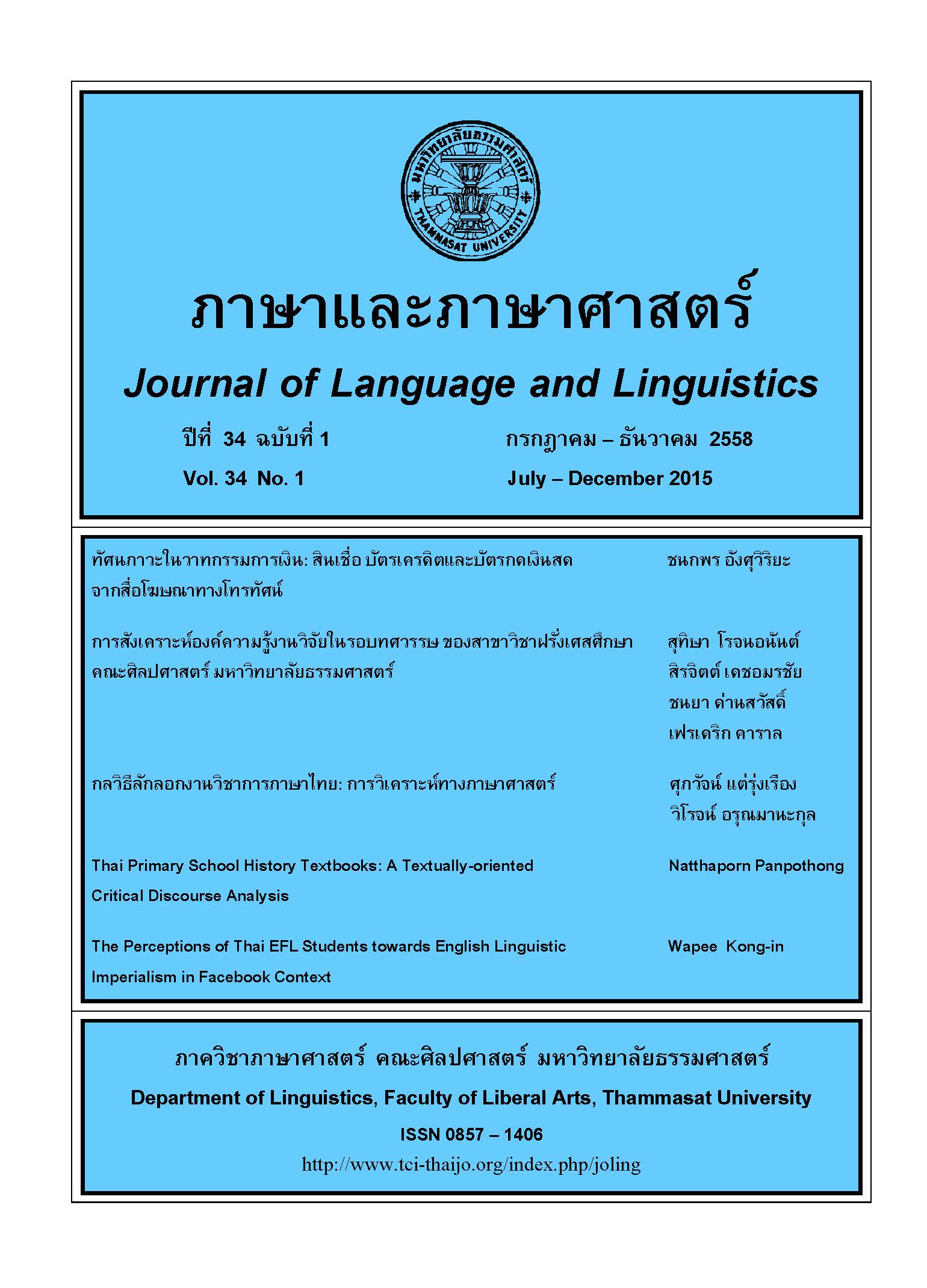Thai Primary School History Textbooks: A Textually-oriented Critical Discourse Analysis
Main Article Content
Abstract
This study aims at examining Thai primary school history textbooks used as principal materials in classes of social studies nationwide. The approach adopted is textually-oriented Critical Discourse Analysis (Sunderland, 2006). In particular, it provides an analysis that focuses on sets of ideas about children and Thai society repeatedly transmitted to the learners through linguistic devices. The findings reveal that these history textbooks not only transmit knowledge about history but also instruct young children about their place, role, and responsibility in Thai society. Indirect strategies of instruction are preferred over direct ones in the text for every grade. The use of invented dialogues serves as the main device of persuasion and indoctrination. In addition, acts of commissives, expressions of desire, the use of the first person plural pronoun together with the modality markers /tßN/‘must or/khu#an/‘should’, lexical choices, and presupposition triggers help to convey the intended meaning. With these devices, adults’ instructions are masked as children’s opinions and desires. In these texts, good children are represented as obedient, dutiful, diligent, and proud to be Thai. Other characteristics that might be essential for learning and daily living such as critical thinking, reasoning, etc. are seldom mentioned. Mostly, Thai society is portrayed as unified and harmonious. The six history textbooks examined here appear to play a crucial role in preparing young children to be good members of Thai society. However, from a critical perspective, the textbooks seem to impose a single version of reality to young children. If the aim of primary education is to help Thai children understand social conditions and develop skills necessary for everyday living, a question we should ask here is whether the one-sided information is enough to help fulfill this mission of Thai primary education.
บทความวิจัยเรื่องนี้มีวัตถุประสงค์เพื่อศึกษาแบบเรียนวิชาประวัติศาสตร์ชั้นประถมศึกษาซึ่งจัดทาขึ้น เพื่อให้เป็นสื่อการเรียนการสอนตามหลักสูตรแกนกลาง ผู้วิจัยมุ่งวิเคราะห์ชุดความคิดเกี่ยวกับเด็กและสังคมไทยที่ ถูกนำเสนอซ้ำ ๆ ผ่านกลวิธีทางภาษาในตัวบทตามแนวคิดวาทกรรมวิเคราะห์เชิงวิพากษ์แบบเน้นตัวบท (Sunderland, 2006) ผลการวิจัยแสดงให้เห็นว่า แบบเรียนชุดนี้มิได้นำเสนอความรู้ด้านประวัติศาสตร์เท่านั้น แต่ยังถ่ายทอดความคิดเกี่ยวกับบทบาทหน้าที่ของเด็กในสังคมไทยด้วย กลวิธีทางภาษาที่ใช้ถ่ายทอดความคิดเป็น กลวิธีแบบอ้อมมากกว่าแบบตรง กล่าวคือ มีการใช้บทสนทนาที่แต่งขึ้นเป็นกลวิธีหลักในการสื่อความ และใน บทสนทนา พบกลวิธีทางภาษาอื่น ๆ ประกอบ เช่น ใช้วัจนกรรมกลุ่มสัญญาแทนวัจนกรรมกลุ่มสั่งให้ทำ ใช้ สรรพนาม “เรา” ร่วมกับคำช่วยกริยา “ต้อง” และ “ควร” ใช้คำศัพท์บางกลุ่มซ้ำ ๆ และใช้รูปภาษาสื่อมูลบท กลวิธี ทางภาษาเหล่านี้ช่วยทำให้ความคิดที่ผู้ใหญ่ต้องการปลูกฝังให้แก่เด็กถูกนำเสนอว่าเป็นความคิดที่มาจากตัวเด็ก เอง ชุดความคิดที่ปรากฏซ้ำ ๆ ในตัวบทนำเสนอภาพของเด็กดีว่าต้องเชื่อฟังผู้ใหญ่ มีความรับผิดชอบ ขยัน และ ภูมิใจในความเป็นไทย คุณลักษณะสำคัญด้านอื่น เช่น การคิดอย่างมีวิจารณญาณ การใช้เหตุผล มิได้ถูกเน้นย้ำ ส่วนภาพแทนของสังคมไทยที่นำเสนอคือภาพของสังคมที่กลมเกลียวกัน ในมุมบวก แบบเรียนชุดนี้มิได้ทำหน้าที่ ให้ความรู้ทางวิชาการเท่านั้น แต่ยังช่วยในการเตรียมเด็กให้เป็นสมาชิกในแบบที่สังคมไทยยอมรับ แต่หากมองใน เชิงวิพากษ์ แบบเรียนชุดนี้ก็มีข้อจำกัดที่ปลูกฝังความคิดแต่เพียงด้านเดียวและนำเสนอภาพสังคมอุดมคติซึ่งต่าง ไปจากสิ่งที่เด็กต้องประสบในสังคมปัจจุบัน
Article Details
บทความทุกบทความเป็นลิขสิทธิ์ของภาษาและภาษาศาสตร์


